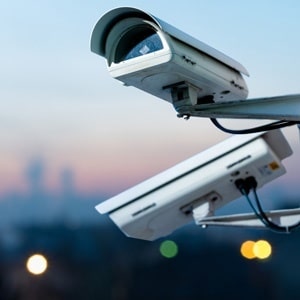Designing for the Edge – 5 Trends in Smart Security
Smart security is moving beyond static surveillance to real-time video analytics, thanks to new capabilities enabled by artificial intelligence (AI). As I discussed in a previous blog post, AI and smart video promise to extract more insights from security video. As more of these always-on systems are rolled out, the edge will play an important role in capturing, collecting, and analyzing higher resolution data. Here are the trends you can expect to see.
- Cameras move beyond ubiquitous fixed security-type cameras
When security technology is brought up in conversation, it is often synonymous with security cameras. These systems have focused on streaming a video feed from a fixed security camera to some central location where it is either being observed in real-time or recorded for future reference. Today, we’re seeing an evolution of smart cameras through the emergence of artificial intelligence.
Thanks to AI, cameras are no longer ‘dumb’ lenses. They’re being tasked to do more – pattern matching and focusing on specific zones or movements. Cameras that used to catch shoplifters after the fact can now identify shoplifting in real-time. Or, these devices can be used to analyze shopper habits. For example, what types of shoppers enter a store and what aisles do they go to? By gaining new insights into buyer habits, stores can create more enjoyable and profitable shopping experiences.
All these smart security cameras no longer just stream video data; they require intelligence and storage within the device itself. In addition, there are more types of cameras being used such as body cameras, dashboard cameras, and new Internet of Things devices and sensors. Video data is so rich you can analyze it and deduce a lot of valuable information in real-time, instead of after the fact.
- Edge-based video analytics for smart security
As the public cloud grew in adoption, companies and organizations saw the platform as a centralized location for big data. But, there’s been a recent trend in the opposite direction. We are now seeing data processed at the edge, rather than the cloud. There is one main reason for this change in preference: latency.
To carry out real-time pattern recognition, latency becomes an issue. It’s very difficult for cameras to process data – 4K surveillance video recorded 24/7 – if it has to go back to a centralized data center hundreds of miles away. This data analysis needs to happen quickly in order to be timely and applicable to dynamic situations, such as public safety. By storing relevant data at the edge, AI inferencing can happen faster. Doing so can lead to safer communities, more effective operations, and smarter infrastructure.
- 4K and Ultra High Definition (UHD) formats becoming ubiquitous
AI-enabled applications and capabilities, such as pattern recognition, depend on high-definition resolutions such as 4K – also known as UHD. This detailed data has a major impact on storage – both the capacity and speeds at which it needs to be written, and the network. Compared to HD, 4K video has much higher storage needs.
As we know, 4K video has four times the number of pixels as HD video. In addition, 4K compliant video supports 8, 10, and 12 bits per channel that translate to 24-, 30- or 36-bit color depth per pixel. A similar pattern holds for HD — more color using 24 bits or less color using 10 or 12 bits in color depth per pixel. Altogether, there is up to a 5.7x increase in bits generated by 4K vs. 1080p video.[1] Larger video files place new demands on data infrastructure for both video production and surveillance.
- Around-the-clock connectivity
Whether designing solutions that have limited connectivity or blazing-fast 5G capabilities, most smart security solutions need to operate 24/7, regardless of their environment. Yet, on occasion, the underlying hardware and software systems fail. In these events, it is important to establish a failover process to ensure continued operation or restore data after a failure, including everything from traffic control to sensors to camera feeds and more.

GET THE WHITE PAPER: ENDURANCE IN SURVEILLANCE

Consider the example of a hospital with dozens or even a hundred cameras connected to a centralized recorder via IP. If the Ethernet goes down, no video can be captured. Such an event could pose a serious threat to the safety and security of hospital patients and staff. For this reason, microSD cards are used in cameras to enable continuous recording. Software tools – powered by AI – can then “patch” missing data streams with the content captured on the card to ensure the video stream can be viewed chronologically with no content gaps.
- Sophisticated device analytics
Self-monitoring has become a critical tool in enabling better uptime, proactive support and efficiency for many systems. Whether in smart factories or enterprise settings, an entire system can fail due to one component malfunctioning. A hard drive can fail due to a broken fan causing its internal temperatures to rise dramatically, for example. By designing an intelligent platform to track device health, systems can be built to work proactively. Our hard drives optimized for smart security are a great example. We monitor a variety of parameters, including temperature, to help administrators take immediate action before reliability is compromised.
Our ability to create advanced device analytics is based on our deep understanding of the thresholds in smart security systems, and what type of behaviors should raise a concern. Similar to drives are our removable surveillance-optimized SD cards. These storage devices are used in smart cameras and are designed to work over several years of non-stop recording. As flash media is finite, you want to be able to monitor the card externally, like a gas gauge, to see how many times it has been rewritten to schedule maintenance before the endurance has been used up.
Learn More
- Read more about edge architectures for smart security
- Find out about the role of deep learning in surveillance
- Explore our smart security portfolio to see beyond surveillance
[1] Based on our Calculate Storage tool. Amount of increase can vary based on compression ratios, video formats and other factors. See tool for full details.





